BY LETTER
Ran (Epsilon Eridani) in 770 AT
History > 0030 to 0900 AT: Solsys Era > 530 to 900 AT: The Sundering
Galactography > Regions of Space > Inner Sphere
Galactography > Regions of Space > Inner Sphere
The state of the Ran system at the time of the creation of the Eridanus League | |
 Image from The Astronomer | |
| The Ran Outpost Flag in use during 770 AT (the so-called 'Hope Flag'). | |
The River of Stars Charter came into effect this year. This is usually assumed to be the founding date of the Eridanus League. In practice, it would take several more years for the Ran Outpost to reform and establish the organization that would govern the Terragens' first interstellar union, but the announcement itself was enough to massively boost the general mood of the system, and the inhabitants of the Ran system were optimistic about the outlook of their future. However, as the colony ships started to trickle in, conflicts began to emerge, and so the peacekeepers of Ran continued to work hard to ensure the stability of the system.
Polity, Government, and Administration | |
| Polity | Polity Name: The Ran Outpost Government type: Confederation Constitution: River of Stars Charter Member polities: 9 - The Socialist Republic of Tasakanna (Mabagan, Marashu) - The Federal Republic of Xinju (Gonsarit, Hatara) - The Bluesky Confederacy (Yuri, Bonpolis) - The Republic of Olivine (Red Dream) - The State of Curie (Curie) - The Islamic Republic of New Maghreb (Jazuli) - The Republic of Balsangi (Balsangi) - The Confederacy of Tunro (Abodo, Gullern, and L'yerban) - The Queendom of Kosmos (Kosmos) |
|---|---|
| Population Demographics | Population: 148,000 sophonts Population breakdown: Biological sophonts: 123,000 - Nearbaseline humans: 53,000 - Baseline humans: 38,000 - Tweaked humans: 17,000 - Rianths: 8,000 - Provolves: 4,000 - Superior humans: 3,000 Bio-AI interface: 22,000 - Cyborgs: 18,000 - Virtuals: 4,000 Sophont AIs: 3,000 - Vecs: 2,000 - Aioids: 1,000 |
| Culture | Languages: Most interpolity communications are done in Ranese dialect of English (later known as Ran Consonance). Internally, many polities often have their own languages; Kosmos, for example, uses a language known as Kosmos Creole, while most of the colonists from the colony ship Bismilla retain their own dialect of Arabic, known simply as Bismilla Arabic. Religions: Diverse. While the majority of the system population is faithless, many religions, including Christianity, Islam, Universalism, Hinduism, Buddhism, and Shenism, are widely adopted by people across the system. Other, less populous faiths include Cosmism, Etodism, Nuagism, and even Gaianism. |
 Image from The Astronomer | |
| The first version of the Eridanus League Flag, devised in 770: a modification of the Hope Flag | |
For more information about this system, see also
Central hub article of the Ran system
History of the Ran system
Ran and the Inner System
Ran (Epsilon Eridani)
A young, active K2V type star, somewhat dimmer than Sol.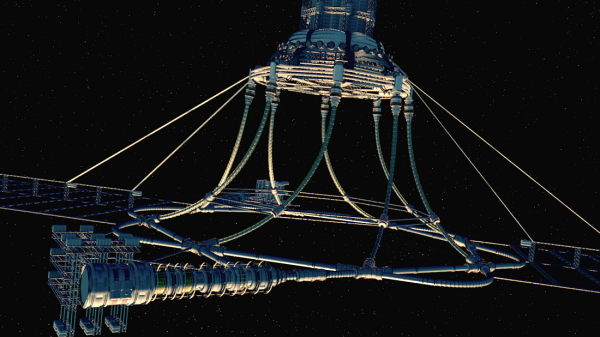 Image from Alex Mulvey | |
| An antimatter farm accelerator array near the star Ran | |
Total Population: 1,000 sophonts.
Low Orbit Space: The space near Ran remains mostly undeveloped; until the last decade, hardly any sophont-made objects can be found here other than some space weather satellites. At the moment, a joint effort to establish two amat farms in close orbit around Ran spearheaded by five most resourceful polities is underway; it is hoped that access to amat would stimulate the system economy by shortening the time required to travel across the system.
Major industries Antimatter production
Dufa
A hot, Venus-like world with a thick atmosphere and a layer of supercritical nitrogen above the rocky surface.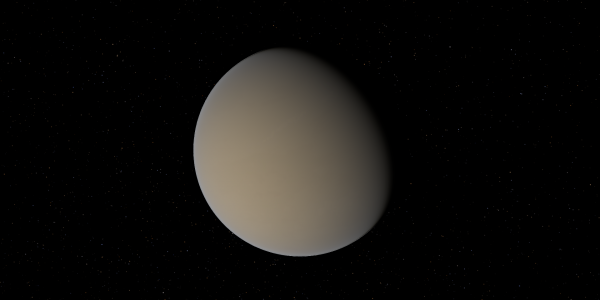 Image from The Astronomer | |
| Dufa in 770 AT | |
Total Population: No permanent population at this time.
Hroenn
A hot, Venus-like world with a thick atmosphere and a layer of supercritical water above the rocky surface..png) Image from The Astronomer |
Total Population: No permanent population at this time; occasionally robotic survey probes venture to this world.
Bara
A terrestrial ocean world with a microbial biosphere. At this early date the world was off-limits to outsiders..png) Image from The Astronomer and Steve Bowers | |
| The research station in orbit around Bara | |
Total Population: ~100 sophonts, in the form of a rotation crew of scientists from Xinju, Bluesky, Olivine, and Tasakanna, in an orbital facility. Permanent settlement is strictly forbidden. Aside from the research station, the sole permanent Terragen occupants of Bara's sphere of influence are some scientific satellites quietly monitoring the world below, and sterilized teleoperated robots surveying the surface.
Unn
A terrestrial world with a microbial biosphere. At this early date the world was off-limits to outsiders. Image from Steve Bowers | |
| A survey robot on the surface of Unn | |
Total Population: ~250 sophonts, in the form of a rotation crew of scientists from Xinju, Bluesky, Olivine, and Tasakanna, in an orbital facility. Permanent settlement is strictly forbidden. Unn receives more scientific attention than its sibling. Hence, there are more satellites and robots here.
The First Ran Belt and the Ægir system
First Ran Belt
A debris disk between Unn and Ægir.Total Population: 21,000 sophonts. Nearly all of them inhabit two habitats: Mabagan (12,000) and Marashu (8,000), both located on the same asteroid. The remaining 1,000 are rotation crews from various polities sent to oversee their respective mining operations.
Belt Space: A large (~200 km across), resource-rich asteroid has been claimed by the colonists aboard the Mabugana, who named it after their ship. Two cities were set up on opposite sides of the object, united under the same banner: the Socialist Republic of Tasakanna. Some of the scientific institutes that deal with the biospheres of Unn and Bara are located here, and so does the spaceport that service spacecrafts that transport researchers to and from the research stations in orbit around those two worlds. As the Mabugana was the only colony ship that carried a significant amount of virtual sophonts (mostly uploads), Tasakanna has the largest virtual sophont population - even after a century of contact with other groups. Elsewhere in the belt, several remote mining operations dot the belt, extracting materials which are then sent back to supply the mother colonies. There is a growing discussion among the citizens of Ran concerning the construction of sterilized vacuum asteroid habitats elsewhere in this region, intended to serve as permanent outposts dedicated to the study and regulation of potentially dangerous objects in the Belt and beyond, as well as the research of potential spread of Terragen microbes in the Belt and the risk they pose to the biospheres of Unn and Bara.
Major Industries: Spacecraft construction and service, high grade computronium manufacturing, asteroid mining, virtual reality synthesis.
Ægir
A Jupiter-mass gas giant with a prominent ring system. Its environment is heavily charged with energetic particle radiation by the young parent star's activity, its volcanic innermost moon, and the planet's powerful magnetosphere.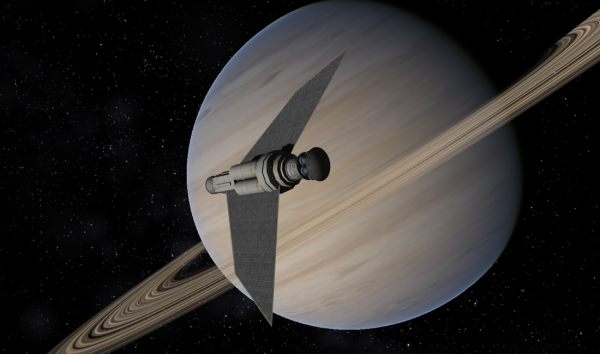 Image from Steve Bowers | |
| The GAIA Ark Bismilla approaches Ægir | |
Total Population: 94,000 sophonts, over half of the system population at this time. This is divided into 26,000 in orbit, and 68,000 on the satellites.
Atmosphere: Although a few atmospheric colonization plans have been proposed, none came to fruition due to the lack of interest from the colonists. The fact that there is no infrastructure that would allow departure from the planet is seen as a deal killer for most, and so does the high surface gravity of this jovian world. Nevertheless, the polities of Xinju, Bluesky and Curie see the colonization of this world a vital part of their long-term development. This, in turn, motivates the proposal of new atmospheric colonization plans from time to time.
Orbital Space: There are two major orbital colonies. The larger one is Curie, an orbital colony set up by some of the colonists aboard the Sanderling, which can be found beyond Gerd's orbit. This colony has been attracting colonists from another orbital colony, Jazuli, eventually sending the latter on track to population and economic collapse. As such, the relationship between the two colonies is deteriorating. The other two orbital colonies, Hatara and Bonpolis, are aligned with the polities of Xinju and Bluesky, respectively.
Major Industries: Microgravity manufacturing, spacecraft construction and service, asteroid and comet mining.
Fimafeng
A rocky moon with heavy volcanism.
 Image from Steve Bowers | |
| Resource extraction near one of Fimafeng's many volcanoes | |
Population: No biont population at this time, as the radiation environment is extremely hostile.
Surface: A rocky, Io-like moon, Fimafeng is the Ægir system's main source of heavy elements. All three polities operate a number of automatic mining operations on the moon. The resemblance extends beyond the abundance of volcanoes and the ease of access to vital resources however; the moon is located within Ægir's deadly radiation belt, and as a result the satellite has never been settled. The idea of the construction of energy production electrodynamic tethers on this world has been put on and off the table multiple times over the past few decades.
Major Industries: Mining, ore processing.
Eldir
An icy moon with heavy cryovolcanism and a subsurface ocean.
Population: 23,000 sophonts, located in one city: Gonsarit.
Surface: This somewhat Ganymede-like moon is primarily settled by the Genetekker faction, who built an underground city known as Gonsarit. A multi-decade-long survey suggested the moon is devoid of life, and so the Genetekkers began introducing their gengineered species to populate their new world. So far they have already succeeded in establishing several small, closed ecosystems independent from the ones in their main habitats, and even developed a population of tweaks suitable for living in the subsurface ocean, but an open ocean ecosystem beyond microscopic life is still some time away. Nevertheless, the city is already beginning to export many of its ecosystem templates to other colonies. In the recent decades, the government of Xinju has been heavily promoting tourism in Gonsarit, opening many of the novel ecosystems as well as advertising various sectors of the settlement. The effort succeeded, and the city's tourism industry is currently booming.
Major Industries: Gengineering, biotech research and development, tourism, aesthetic ecosystem designing.
Ægir-Eldir L5
The L5 Lagrange point of Ægir and Eldir
Population: No permanent population at this time, apart from boostbeam maintenance staff
Description: This is the location of the Ægir system's boostbeam complex, used to accelerate interplanetary craft within the Ran Outpost system. This complex is not yet powerful enough to accelerate crewed interstellar spacecraft.
Gerd
An icy moon with heavy cryovolcanism and a subsurface ocean.
Population: 41,000 sophonts, located in three cities: Yuri (22,000), Red Dream (16,000), and Amity (3,000).
Surface: Both the Cislunese and the Martians settled on this moon. They are fairly successful at attracting colonists from the Bismilla and the Sanderling, most of whom also hailed from the inner Solsys (especially Earth). The Cislunese colony Yuri consists of one big dome some 15 km across, containing a rough recreation of one of Earth's many ecosystems, and a network of tunnel habitation areas below. The Martian colony Red Dream is similar, but has a number of connected surface domes instead of one. The environment inside Red Dream is optimized for the tweaks, and is inhospitably cold and oxygen-starved to unaltered humans. Both of these colonies possess advanced industrial capabilities, allowing them to mass produce and export affordable high tech products that form the backbone of the system economy. The third settlement, Amity, was established in 710 as a symbol of friendship between the three polities more than anything practical, although thanks to the fascinating blend of architecture and features of the three nations, such as a Genetekker Beta memorial park sitting right next to Cislunar moon shrine, for example, it has grown into a decently popular tourist spot in its own right.
Major Industries: General high tech manufacturing, tourism, drytech research and development.
Outer Irregular Moons of Ægir
Small captured asteroidal objects in distant, highly eccentric, and inclined orbits.
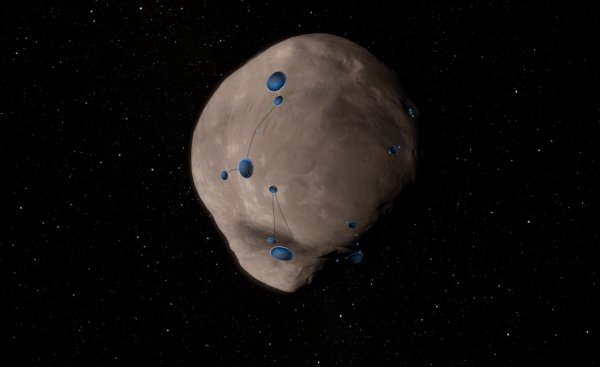 Image from Steve Bowers | |
| The Balsangi colony in 770 AT, showing several inflatable domes for collecting volatile materials from mines | |
Population: 4,000 sophonts, all located in a single asteroid habitat known as Balsangi.
Description: A group aboard the Bismilla hailing from the Cererean culture of Balsan elected to set up their own colony on one of the irregular moons, which they named Balsangi. This colony is dependent on supplies from the inner Ægir system colonists, primarily Yuri, which they have been getting closer politically. In return, they operate two of the system's communication stations. Elsewhere in the system, several similar communication stations managed by the Ran Outpost are trained to star systems where contact has been established, continuously trading information with them.
Major Industries: Asteroid and comet mining, interstellar communications, observatory operation.
Ran-Ægir L4
The L4 Lagrange point of Ran and Ægir; a Trojan group of asteroidal objects can be found at this location.
Population: No permanent sophont population at this time.
Description: Autonomous observatories operated by the Ran Outpost are located here. These are in charge of watching all nearby star systems, home to bionts or not. The facilities here are instrumental in the system's continuous observation of the neighboring Violets (Gliese 65) system, which is known to host ahuman aioid civilization known to the Interplanetary Age biont observers as the Solipsist League.
The Outer System
Second Ran Belt
A debris disk between Ægir and Hefring.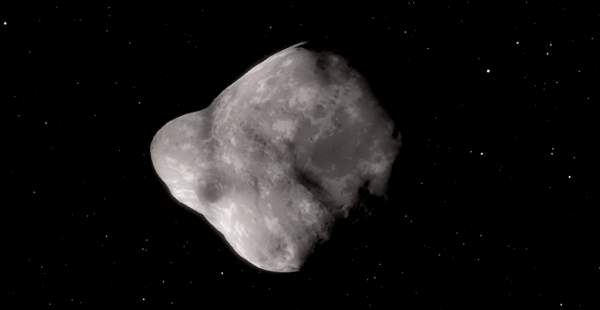 Image from Steve Bowers | |
| Oasmar asteroid in the Second Ran Belt; this object has been surveyed in some detail, and mining will commence in the near future | |
Total Population: No permanent population at this time
Belt Space: The Second belt is currently devoid of permanent inhabitants, and there are virtually no mining operations here yet.
Hefring
A Neptune-like world with a prominent ring system.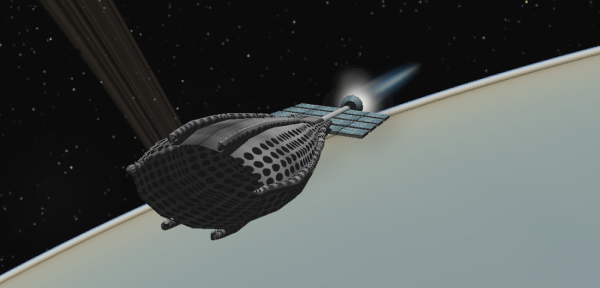 Image from Steve Bowers and The Astronomer | |
| A scoopship collects resources from the atmosphere of Hefring | |
Total Population: 16,000 sophonts, all in orbit.
Atmosphere: Plans of the construction of Lan, a floating city in the atmosphere of Hefring, are being discussed. The city would primarily serve as a base of operation for the gas mining jets, which should dramatically increase the gas production.
Orbital Space: As the least massive planet, Hefring is also the easiest to escape from, therefore it is the best location in the Ran system for gas mining. This manifested in the form of several scoops operated by the Ran Outpost in eccentric orbits, swinging by the planet's outer atmosphere to extract useful gases like deuterium and helium at periapsis before unloading refined gas at the apoapsis. The inhabitants of the system reside in three habitat complexes: Abodo, Gullern, and L'yerban, each of which have extensive contact with the others and operate as a single polity known as the Confederacy of Tunro.
Major Industries: Gas mining, tourism, spacecraft construction, habitat designing.
Miseta
An icy moon.
Population: No permanent population at this time
Surface: The Confederacy of Tunro has agreed with the Ran Outpost to help with the construction of an interstellar-grade boostbeam station on this moon, although so far the project hasn't proceeded beyond the drawing board yet.
Hefring-Miseta L4
The L4 Lagrange point of Hefring and Miseta
Population: 0 sophonts
Description: This is the location of the Hefring system's boostbeam complex.
Himinglaeva
A massive Neptune-like world with a prominent ring system. Image from Steve Bowers | |
| The Kosmos orbiting Himinglaeva | |
Total Population: 1 aioid and 16,000 bionts. All permanent inhabitants of Himinglaeva are affiliated with the polity known as the Queendom of Kosmos, an aiocratic society evolved on the starship Kosmos.
Orbital Space: The interstellar vessel Kosmos is currently parked in orbit around Himinglaeva, where it has been converted into a continuously-expanding habitat. Every few months, new habitation modules are added, and occasionally the centrifuge rings are expanded, providing more and more space for the colonists. Concurrently, the ship's processing modules are also being continuously updated and expanded, to improve the polity's virtual environments and services. The Kosmos aioid also upgrades emself in an sporadic fashion, mostly to be able to keep up providing comfort to its growing population. Although the ship only arrived 13 years ago, the Kosmos has already become a popular tourist destination, in no small part due to its unique, wondrous, and almost escapist culture, and the economy of the settlement is heavily reliant on this industry.
Major Industries: Tourism, entertainment, virchmaking, general-use computronium manufacturing.
Third Ran Belt
A debris disk beyond Himinglaeva.Total Population: No permanent sophont population at this time. This remote location has seen a few visitors, mostly in the form of scientific expeditions.
The Ran Outer Cloud
A vast, roughly spherical volume thinly populated by icy objects.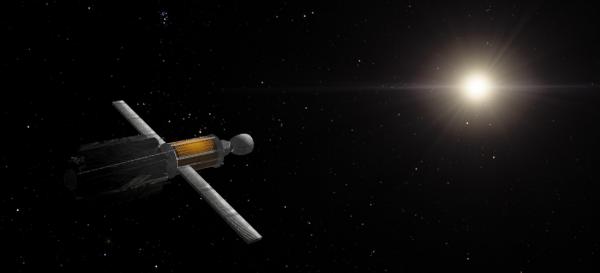 Image from Steve Bowers | |
| An inflatable telescope departs for the Ran Oort cloud, where it will use the gravitational foci of Ran to observe nearby systems. | |
Total Population: No permanent sophont population at this time.
Description: As part of the Project Observant Ndidi, which aims to enable detailed observation of all nearby stars out to roughly 30 light-years, Several telescopes are being sent out of the system in order to reach the focal distance where the star's gravitational field can be used to massively boost the resolving capacity of these telescopes.
Related Articles
Appears in Topics
Development Notes
Text by The Astronomer
Additional material by Dangerous Safety, Rakuen07, Steve Bowers, Todd Drashner, Ryan B (Rynn)
Initially published on 24 May 2021.
Additional material by Dangerous Safety, Rakuen07, Steve Bowers, Todd Drashner, Ryan B (Rynn)
Initially published on 24 May 2021.






